Battle of Fuentes de Ońoro
The Battle Illustrated
with Modern Photographs
of the Scene
Historical Account
Article and Photographs © John Salmon
| |
A Brief Summary of the Campaign
At right, View from the ruins of Fort Conception. This area was held by the 5th division and was not seriously threatened.
The French had retreated to the Portuguese Spanish boarder whilst being harried by Wellington's forces, only the fortress town of Almeida held out under siege. With an eye on Napoleon's displeasure at the failure of his Portuguese campagn Massena was determined to hold Almeida. The French Army of Portugal would then be able to claim that it occupied at least one major fortress within Portugal. To do so Massena needed to re-supply the fortress and if possible drive Wellington away. Wellington was equally determined to stop Massena re supply efforts and continue the siege until Almeda fell.
On the 2nd of May Massena advanced from Ciudad Rodrigo via the Espeja road and found Wellington barring his path at the little village of Fuentes de Onőro. Massena had approximately 49,000 troops to Wellington's 37,000 but for once the allies had a superiority in artillery, 48 guns to the French 38. [1]
At right, the ruins of Fort Conception--the anchor of Wellington's left flank.
There were demonstrations and minor French attacks against this area on the 3rd and 5th but it was not seriously threatened. To the South the terrain opened up and was better suited to cavalry, this area was lightly held by Spanish irregular and British cavalry. Fuentes de Onőro itself is a maze of narrow streets and high walls, it reminded me of the little stone built villages of the Derbyshire Peak District, perhaps this is how they looked two hundred years ago.
At right, area to the east of Fuestes de Onoro. It was from here that the French forces formed up to make teir attacks upon the village.
A second French attack succeeded in crossing the stream and drove Wellington's men to the ridge beyond the village. Wellington, as usual, was on hand and ordered in reinforcements to retake the village. By nightfall the village west of the stream was back in his hands.
This day started relatively quiet, a mist covered the battlefiled and a truce was called to tend wounded and remove bodies. Wellington considered his position. If the French were to attack his southern flank, then he should move troops south to reinforce his flank, but this would weaken the northern flank and route to Almeida would be uncovered. If his southern flank was turned then his main communications back to Portugal and Lisbon would be endangered. Also if he was forced to retreat towards Almeida there has only a narrow track over terrain that artillery and wagons would find impossible. A retreat in that direction would turn into a disaster. However Wellington had no intention of retreating, instead he lightly reinforced the line to the south with the 7th division and awaited events.
Sure enough come the foggy dawn French forces attacked the weakly held southern flank.
Spanish irregulars under Julian Sanchez and the British cavalry were pushed back, the battalions of the 7th division fared little better and were soon in a bad situation. Wellington ordered the Light Division with its commander, Robert Craufurd newly arrived back from leave, to move South and cover the retreat of the 7th division. By skilful use of cover, firing and retiring, then forming squares when cavalry threatened and marching in formation the Light division covered the retreat. It was over this ground that Ramsay's horse artillery made their famous escape from the French cavalry. Napier gives us a dramatic description of this memorable event.
"The French ... with one shock drove in all the [British] cavalry out guards, and cutting off captain Ramsay's battery, came sweeping in upon the reserves of horse [cavalry] and upon the seventh division. But their leading squadrons approaching in a disorderly manner, were partially checked by the British, and at the same time a great commotion was observed in their main body. Men and horses there closed with confusion, and loud cries, and the sparkling of blades and the flashing of pistols, indicated some extraordinary occurrence.
Suddenly the multitude became violently agitated, an English shout pealed high and clear, the mass was rent asunder, and Norman Ramsay burst forth at the head of his battery, his horses breathing fire, stretched like greyhounds along the plain, the guns bounded behind them like things of no weight, and the mounted gunners followed in close career. Captain Brotherton of the 14th dragoons, seeing this, instantly rode forth and with a squadron, and overturned the head of the pursuing troops, . . . "
[2]
Eventually a new line was stabilised at right angels to the main line, however Wellingtons communications with Portugal and best line of retreat were now cut.
As the Light division withdrawal was being completed the French again attacked Fuentes de Onőro, pushing the British back. Two companies of the 79th were trapped in the narrow streets and all but wiped out, but the British rallied and forced the French back to the stream. Again the French attacked, this time pushing the British back to the church and the high ground. Once more Wellington ordered a counter attack which pushed back the French.
At right, the narrow winding lanes became heaped with bodies of the dead and wounded. One false turn and tropps of both sides would find themselves trapped ina cul de sac--which could soon become a death trap.
Bayonets were used to good effect, soon the fighting was back in the body strewn streets of the village. It must have been a bloody struggle as bit by bit the French were pushed back. This time it was the turn of French troops to become isolated in the maze of streets and slaughter in revenge for the 79th. Massena ordered yet another attack but his troops had had enough, the assault was not pressed and soon petered out. That night Wellington entrenched his position, the only time he did this in the Peninsula.
Next day, Massena manoeuvred cavalry around but could find no way through to Almeida, and abandoned attempts to relieve the fortress. He did however manage to slip a message into the fortress ordering governor Brennier and his troops to escape.
Fuentes de Onőro is one of Wellingtons more controversial battles, losses were 2,192 French to 1,545 Allied. It could be argued that he came closer to defeat here than in any other of his Peninsula battles. Indeed Massena claimed a victory which no one, least of all Napoleon, believed. The Emperor sent a biting reply to the Marshall's claim, 'His majesty is distressed . . . to see his army retire before a British force so inferior in numbers.' [4] Wellington's comment was that, 'If Boney had been there we would have been beaten'. [5]
David Chandler, Dictionary of the Napoleonic Wars, published by Greenhill Books, 1993.
Many thanks to Alan Rooney and Ian Fletcher of Midas Battlefield Tours for a most interesting and enjoyable trip to Spain in 1995. This allowed me to view many Peninsular War fortresses and battlefields including Fuentes de Onoro, Almeida and Fort Conception.enjoyable trip to Spain in 1995. This allowed me to view many Peninsular War fortresses and battlefields including Fuentes de Onoro, Almeida and Fort Conception.
Finally and always, many thanks to my wife Elizabeth who has to proof read this and many other efforts, her patience is never ending.
[1] All numbers of troops involved and casualties taken from David Chandler's Dictionary of the Napoleonic Wars, published by Greenhill Books, 1993, p 164.
More Fuentes de Onoro
|
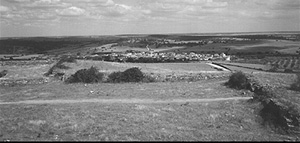 By the spring of 1811 the fortunes of war in the Iberian Peninsular had moved marginally in favour of the allies. Marshal Massena's invasion of Portugal had failed before the Lines of Torres Vedras and the effects of a long hard winter fighting the cold and Portuguese guerrillas.
By the spring of 1811 the fortunes of war in the Iberian Peninsular had moved marginally in favour of the allies. Marshal Massena's invasion of Portugal had failed before the Lines of Torres Vedras and the effects of a long hard winter fighting the cold and Portuguese guerrillas.
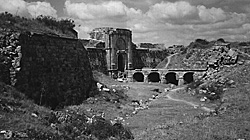 Wellington's position was centred on the village of Fuentes de Onőro but stretched away to the north along the hills towards the ruins of Fort Conception. This fort covered the route to Almeida, although Wellington had ordered it blown up the year before during the retreat it was still a considerable fortification.
Wellington's position was centred on the village of Fuentes de Onőro but stretched away to the north along the hills towards the ruins of Fort Conception. This fort covered the route to Almeida, although Wellington had ordered it blown up the year before during the retreat it was still a considerable fortification.
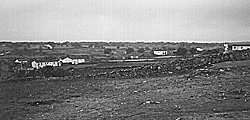 It was against the village that the main attack took place on this day. At about 2.00pm 10 French Battalions stormed into the village, were held at the line of the stream but did gain a small foothold on the western bank. A counter attack pushed them back out of the village.
It was against the village that the main attack took place on this day. At about 2.00pm 10 French Battalions stormed into the village, were held at the line of the stream but did gain a small foothold on the western bank. A counter attack pushed them back out of the village.
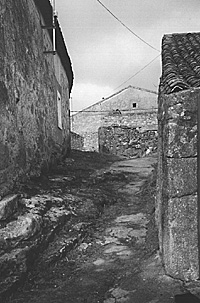 Now Massena ordered an attack by two full divisions. Weight of numbers told and the British were pushed back this time out of the village. Wellington with his skill of placing reinforcements in the right position at the right time had troops ready to counter attack, which they did in column, hitting the by now disordered French.
Now Massena ordered an attack by two full divisions. Weight of numbers told and the British were pushed back this time out of the village. Wellington with his skill of placing reinforcements in the right position at the right time had troops ready to counter attack, which they did in column, hitting the by now disordered French.
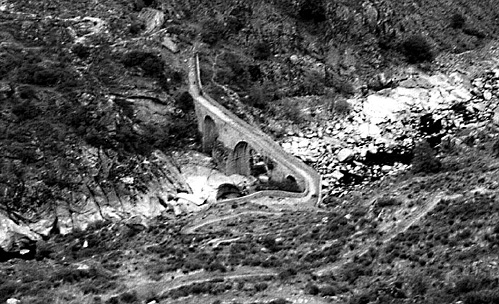 The governor blew up the fortress, then by bluff and a lot of luck escaped with most of his troops over the Bridge of Barba del Puerco (at right). This was due in large part to the incompetence of the siege commander, General Erskin. An event that caused Wellington to explode in his own right, saying it was ' . . . the most disgraceful military event that has yet occurred to us.' [3] With the escape of the governor and his troops, most of the gains of a hard fought battle had been thrown away.
The governor blew up the fortress, then by bluff and a lot of luck escaped with most of his troops over the Bridge of Barba del Puerco (at right). This was due in large part to the incompetence of the siege commander, General Erskin. An event that caused Wellington to explode in his own right, saying it was ' . . . the most disgraceful military event that has yet occurred to us.' [3] With the escape of the governor and his troops, most of the gains of a hard fought battle had been thrown away.